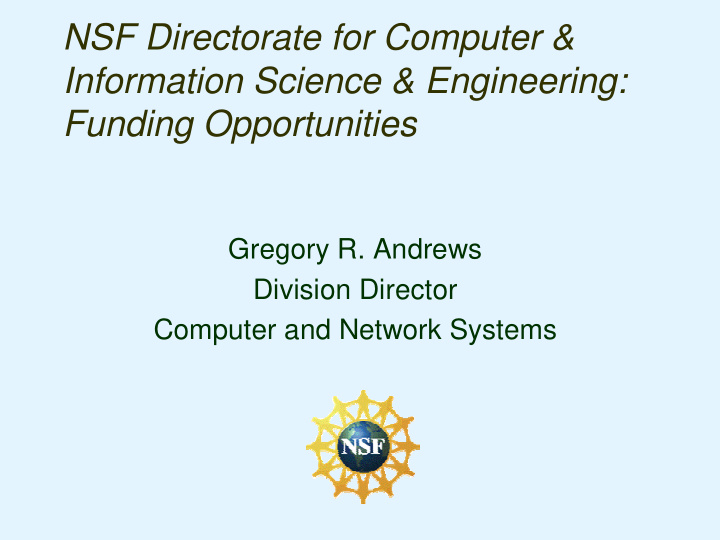



NSF Directorate for Computer & Information Science & Engineering: Funding Opportunities Gregory R. Andrews Division Director Computer and Network Systems
Outline • Context – CISE strategic objectives – CISE reorganization: drivers and goals • Details – Divisions, clusters, programs – FY 2004 activities; FY 2005 plans 2
CISE Strategic Objectives • Enhance research portfolio – Strengthen the core – Cyberinfrastructure – Cybersecurity • Broaden participation • Improve organizational effectiveness 3
CISE Reorganization: Drivers • Scientific: changes to the field – Had essentially the same organization from 1985 to 2003 • Administrative: proposal pressure – Up 125% from 1997 to 2003 (vs. 16% for NSF); up even more in FY 2004 • Financial: end of ITR – How to invest those funds? 4
CISE Reorganization: Goals • Align divisions to reflect the field • Group similar programs into clusters – Sharpen focus – Increase flexibility – Eventually increase grant size & duration • Develop cross-cutting emphasis areas • Integrate education and research • Build on success of ITR 5
New CISE Organization Office of the Assistant Director Computing and Computer and Information and Shared Communications Network Intelligent Cyberinfrastructure Foundations Systems Systems (SCI) (CCF) (CNS) (IIS) 6
Computing and Communication Foundations (CCF) • Formal and Mathematical Foundations – Computer science theory; numerical computing; computational algebra and geometry; signal processing and communication • Foundations of Computing Processes and Artifacts – Software engineering; software tools for HPC; programming languages; compilers; computer architecture; graphics and visualization • Emerging Models for Technology and Computation – Computational biology; quantum computing; nano-scale computing; biologically inspired computing 7
CCF Competitions • FY 2004 – Responsible for about 2030 proposals – Heavy mortgages and commitments – Decent success rates for CAREER (15%) but terrible success rates for clusters (5%) • FY 2005 and FY 2006 – CAREER competitions both years – Formal and Mathematical Foundations, and Emerging Models for Technology and Computation: November 2004 but no competition in FY 2006 – Foundations of Computing Processes and Artifacts: May 2005 with funds from FY 2006 budget • FY 2007: Fall deadlines for all three clusters 8
Computer and Network Systems (CNS) • Computer Systems – Distributed systems; embedded and hybrid systems; next- generation software; parallel systems • Network Systems – Networking research broadly defined plus focus areas in programmable wireless networks and networks of sensor systems • Computing Research Infrastructure – Research infrastructure; minority institutional infrastructure; research resources • Education and Workforce – Curriculum development/educational innovation; IT workforce; special projects; cross-directorate activities (e.g., REU sites) 9
CNS Competitions • FY 2004 – Responsible for about 2035 proposals – Good success rates on CAREER and infrastructure (30%) – Fair success rates on most other programs (10-15%) • FY 2005 — One solicitation per cluster – CAREER: July deadline as usual – Computer systems: November 2004 – Network systems: December 2004 – Computing Research Infrastructure: late August deadline (late July for letters of intent for large proposals) – Education and Workforce: January 2005 • FY 2006: Same deadlines as in FY 2005 10
Information and Intelligent Systems (IIS) • Systems in Context – Human computer interaction; educational technology; robotics; computer-supported cooperative work; digital government • Understanding, Inference, and Data – Databases; artificial intelligence; text, image, speech, and video analysis; information retrieval; knowledge systems • Science & Engineering Informatics/Information Integration – Bioinformatics; geoinformatics; cognitive neuroscience; … 11
IIS Competitions • FY 2004 – Responsible for about 2590 proposals – Success rates of 17% CAREER, 5% regular programs • FY 2005 – Raise acceptance rate of 2004 to 12-15% – CAREER in July as normal – Science & Engineering Informatics/Information Integration and Universal Access: December 2004 – Data, Inference, and Understanding and Systems in Context: May 2005 with most funding from FY 2006 • FY 2006: Same deadlines as in FY 2005 12
Shared Cyberinfrastructure (SCI) • Infrastructure Development – Creating, testing, and hardening next-generation deployed systems • Infrastructure Deployment – Planning, construction, commissioning, and operations 13
SCI Competitions • FY 2004 – NSF Middleware Initiative (NMI): 140 proposals; expected success rate of 10-15% – International Network Connections: in panels • FY 2005 – Continuing support for centers (PACI, ETF) – Cyberinfrastructure Teaching, Education, Advancement, and Mentoring (CI-TEAM): early 2005 – NSF Middleware Initiative (NMI): spring 2005 – Leveraging and coordinating shared and domain-specific cyberinfrastructure: contact a program director if you have ideas for leveraging CISE research – Some programs with other agencies/directorates 14
Cross-Cutting Emphasis Areas • Characteristics – cut across clusters and divisions – address scientific or national priorities • FY04 Emphasis Areas – Cyber Trust: 488 proposals – Science of Design: 182 proposals – Information Integration: 250 proposals • FY 2005 Emphasis Areas – Cyber Trust: January 2005 – Science of Design: spring 2005 – Information Integration: December 2004 – Broadening Participation: late winter/early spring 2005 – Possibly one more 15
Summary • FY 2004 – Transition to clusters and emphasis areas – Last year of ITR • FY 2005 – All clusters and emphasis areas in place – Reduced competitions in CCF and IIS due to severe budget constraints • FY 2006 – Back to normal operations (FY 2007 for CCF) 16
Further Information • CISE Web site: www.cise.nsf.gov • Computing Research News bimonthly columns: www.cra.org • Handouts – Crosswalk from old to new programs – Copy of these slides 17
Recommend
More recommend